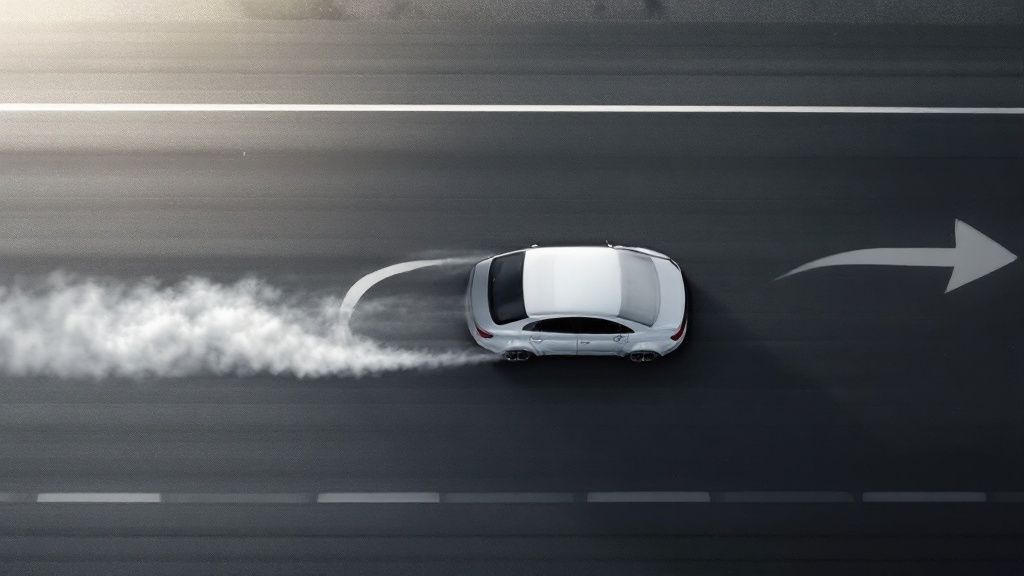Spotting the Red Flags: Alignment Issues and Your Car
A well-aligned car is essential for safety and fuel efficiency. Ignoring alignment problems can lead to premature tire wear and compromised handling. This listicle outlines six clear signs your car needs alignment, empowering you to address the issue quickly. Learn to recognize these indicators, whether you’re experiencing vehicle pulling, uneven tire wear, or a crooked steering wheel. Knowing these signs can save you money on tires and ensure a safer, more enjoyable driving experience.
1. Vehicle Pulling to One Side
One of the most obvious and common signs your car needs alignment is when your vehicle consistently drifts or pulls to the left or right while driving on a level road, even when you’re holding the steering wheel straight. This pull, a key indicator of misalignment, happens because your wheels aren’t correctly aligned with each other. This misalignment creates an uneven distribution of forces, pushing your car in a specific direction. This can manifest as a noticeable drift or a constant need to correct your steering to stay in your lane, ultimately impacting your vehicle’s handling and safety. For drivers in Fort Worth, recognizing this crucial sign can prevent further damage and ensure a smooth, safe driving experience.

This pulling sensation can manifest in several ways: a noticeable drift in a specific direction without driver input, worsening at higher speeds, occurring immediately after impacting potholes or curbs, or being more pronounced on certain road surfaces. For owners of high-mileage or aging vehicles in Fort Worth, this might be a recurring issue due to wear and tear on suspension components. Fleet managers and small business owners should also be vigilant about this sign, as consistent misalignment can lead to increased tire wear and reduced fuel efficiency across their fleet, impacting their bottom line.
Pros of using this as a diagnostic method:
- Easy to detect: You don’t need specialized equipment to notice your car pulling.
- Clear indicator: It’s a strong sign of alignment issues and isn’t easily attributed to other problems.
- Early warning: Often noticeable before more serious damage occurs.
Cons of relying solely on this method:
- Could indicate other issues: Uneven tire pressure or brake problems can also cause pulling. Always check your tire pressure first.
- Gradual development: The pulling might develop slowly, making it less noticeable until it becomes severe.
- Driver compensation: Some drivers unconsciously compensate for the pull by adjusting their steering, delaying the necessary alignment service.
Examples:
- A Honda Civic consistently veering left on straight highways after hitting a large pothole.
- A Toyota Camry pulling right after having new tires installed only on one side.
Tips for Identifying and Addressing Pulling:
- Test it safely: Briefly and cautiously remove your hands from the steering wheel for a second or two on an empty, straight road at a moderate speed to feel for any pull.
- Compare surfaces: Observe if the pulling sensation changes on different road surfaces.
- Check tire pressure: Ensure your tires are properly inflated before assuming alignment issues. For budget-conscious drivers, this simple check can prevent unnecessary expenses.
- Don’t delay repairs: Addressing alignment issues promptly prevents uneven tire wear, improves fuel efficiency, and ensures safer handling, crucial for safety- and performance-focused motorists.
This sign deserves its place on the list because it’s a primary indicator of alignment problems, easily detectable by most drivers, and can prevent more costly repairs down the line if addressed promptly. Whether you’re a budget-conscious driver in Fort Worth or prioritize safety and performance, recognizing and addressing this issue is essential for maintaining your vehicle’s health and your peace of mind.
2. Uneven or Rapid Tire Wear
One of the most telling signs your car needs alignment is uneven or rapid tire wear. When your wheels are misaligned, they sit at improper angles, forcing your tires to make contact with the road unevenly. This irregular contact creates excessive friction on certain parts of the tire tread, leading to accelerated wear and tear. Instead of wearing down evenly over time, misaligned tires develop distinct patterns of wear and often wear out much faster than their expected lifespan. This not only compromises your safety and performance but also hits your wallet harder with the need for more frequent tire replacements.

Several key features distinguish alignment-related tire wear. Look for wear concentrated on the inner or outer edges of the tires. Scalloped or feathered wear patterns across the tread are another indicator. You might also see a visible difference in tread depth across the same tire. Often, the front tires will show more significant wear than the rear tires. For example, a Ford F-150 experiencing inner edge wear on its front tires after off-roading points towards a likely alignment issue. Similarly, a BMW 3-Series showing a feathered wear pattern after a suspension lowering without a subsequent alignment also suggests a need for adjustment.
This sign deserves a prominent place on this list because it provides tangible, physical evidence of alignment problems. It’s something you or a mechanic can spot during a routine inspection, often confirming suspected alignment issues. This visual cue makes it easy for even non-mechanics to understand the potential problem.
Pros:
- Clear visual indicator of alignment problems.
- Easily detected during regular tire inspections.
- Confirms suspicions about misalignment.
Cons:
- By the time the wear is visible, significant tire damage may have already occurred.
- Necessitates tire replacement in addition to the alignment service, increasing the overall cost.
- Uneven tire wear can also stem from improper inflation or underlying suspension issues, so further diagnosis may be necessary.
Actionable Tips for Fort Worth Drivers:
- The Penny Test: Place a penny head-down into the tire tread grooves across different sections of each tire. If you can see the top of Lincoln’s head, your tread is too low and likely unevenly worn.
- Comprehensive Inspection: Don’t just check one tire. Inspect all four, as patterns across different tires can provide clues about specific alignment issues.
- Photographic Evidence: Take clear photos of the tire wear patterns. These visuals can be helpful when you’re seeking a professional assessment from a mechanic in Fort Worth.
- Regular Tire Rotation: Regular tire rotation (every 5,000-8,000 miles) can help distribute wear more evenly and may help identify alignment issues before they cause severe damage. This is especially important for high-mileage vehicles or those used for frequent commuting in Fort Worth.
Tire wear guides from companies like Michelin and alignment education materials from providers like Firestone Complete Auto Care have popularized the understanding of how tire wear patterns relate to vehicle alignment. Addressing this issue promptly can save Fort Worth drivers money on premature tire replacements, ensure safer handling, and improve overall vehicle performance.
3. Off-Center or Crooked Steering Wheel
One of the most obvious signs your car needs alignment is a crooked or off-center steering wheel. When driving straight ahead on a level road, your steering wheel should be perfectly centered, with the emblem or logo sitting horizontally. If you notice the steering wheel is tilted to one side, even though the car is traveling straight, it’s a strong indicator of an alignment issue. This usually means the wheels are actually pointing straight ahead, allowing you to drive straight, but the steering wheel itself wasn’t correctly positioned during a previous alignment service.

This misalignment can stem from several factors, including hitting potholes or other road hazards, or even after seemingly unrelated work like suspension modifications. For example, a Subaru Outback owner might notice their steering wheel tilted 20 degrees clockwise after hitting a pothole during the winter. Similarly, a Mercedes C-Class owner could experience an off-center steering wheel following DIY suspension work. This symptom deserves a place on this list because it’s often the first thing drivers notice, signaling a potential problem that shouldn’t be ignored. While a crooked steering wheel might not immediately impact drivability, it can mask other more serious alignment issues and could lead to the development of bad steering habits as the driver compensates for the offset.
Features of this alignment issue:
- Steering wheel rests at an angle when driving straight.
- Center emblem or logo is noticeably off-center.
- Vehicle drives straight but the steering wheel is not level.
- May appear after hitting road hazards or previous alignment work.
Pros of recognizing this symptom:
- Immediately visible to the driver without special knowledge.
- Doesn’t typically affect drivability or safety initially.
- Usually indicates a simpler alignment issue (often just a toe adjustment is needed).
Cons of ignoring this symptom:
- Easily ignored since the car may still drive straight.
- Can mask other, potentially more serious, alignment problems.
- May cause the driver to develop bad steering habits to compensate.
Actionable Tips:
- Before taking your car for an alignment service, mark the center position of your steering wheel. This will help you verify if the mechanic has correctly centered the wheel after the alignment.
- Specifically mention the off-center steering wheel to your mechanic. This ensures they address the issue directly and don’t overlook it.
- Test the steering wheel position yourself. Find a straight, empty road and observe the steering wheel position while driving straight.
- Determine if the issue developed suddenly (after an impact) or gradually (possible suspension wear). This information can help diagnose the underlying cause.
By paying attention to your steering wheel’s position and following these tips, you can ensure your car’s alignment is correct, promoting even tire wear, optimal fuel efficiency, and a comfortable driving experience. This is especially important for Fort Worth drivers, whether you’re a budget-conscious individual, a fleet manager, or simply a safety- and performance-focused motorist. Catching alignment issues early can save you money on tires and other repairs in the long run.
4. Steering Wheel Vibration
One of the most common and noticeable signs your car needs alignment is steering wheel vibration. This trembling or shaking sensation, often felt through the steering wheel, occurs when your wheels are not pointing in the direction they should be. Instead of rolling smoothly in unison, misaligned wheels fight against each other, generating forces that transmit up through the steering column. This creates the vibration you feel, often increasing in intensity at higher speeds. While vibration can originate from several sources, such as tire imbalance or worn suspension components, vibration specifically related to misalignment typically worsens with speed and can be accompanied by the vehicle pulling to one side.

This vibration deserves a prominent place on this list of signs your car needs alignment because it’s a tactile feedback mechanism that’s hard to ignore, often prompting drivers in Fort Worth and elsewhere to seek repairs before more severe damage occurs. This is especially important for budget-conscious drivers as addressing alignment issues early can prevent premature tire wear and other costly repairs. For owners of high-mileage or aging vehicles in Fort Worth, steering wheel vibration can be an early warning sign of developing alignment problems that could compromise safety. Even for safety- and performance-focused motorists, a vibrating steering wheel can indicate a misalignment affecting handling and responsiveness.
Features of Alignment-Related Steering Wheel Vibration:
- Trembling or shaking sensation in the steering wheel: The vibration can range from a subtle hum to a violent shaking depending on the severity of the misalignment.
- Often speed-dependent: The vibration may be barely noticeable at low speeds but become increasingly pronounced as you accelerate, particularly at highway speeds.
- Sometimes accompanied by vehicle pulling: If your car drifts to one side even when you’re holding the steering wheel straight, this combined with vibration is a strong indicator of an alignment problem.
- May increase during acceleration or braking: Changes in force applied to the wheels can exacerbate the vibration.
Pros of Recognizing Steering Wheel Vibration as an Alignment Issue:
- Provides tactile feedback that’s difficult to ignore: Unlike some other signs of misalignment, steering wheel vibration demands attention.
- Often prompts drivers to seek repairs before severe damage occurs: Early intervention can save money on tires and other components.
- Can help diagnose alignment issues before visible tire wear appears: Catching misalignment early can prevent uneven tire wear, maximizing tire lifespan.
Cons of Relying Solely on Steering Wheel Vibration for Diagnosis:
- Easily confused with other issues: Tire imbalance, worn suspension components, and brake problems can also cause vibrations.
- May come and go depending on road surface: This can make pinpointing the cause more challenging.
- Often requires professional equipment: Accurate diagnosis requires specialized alignment equipment found in reputable Fort Worth auto shops.
Examples:
- A Jeep Wrangler experiencing steering wheel vibration after installing larger tires without a subsequent alignment.
- A Nissan Altima developing a steering wheel shake between 55-65 mph after hitting a curb.
Actionable Tips for Fort Worth Drivers:
- Note when and at what speeds the vibration occurs: This information will help a mechanic diagnose the problem.
- Consider having your tires balanced before an alignment: This can rule out a simpler and less expensive fix. Many Fort Worth tire shops offer this service.
- Test if the vibration changes when turning slightly left or right: This can provide further clues about the source of the vibration.
- Check for loose lug nuts or obvious tire damage: Eliminate the most obvious causes before assuming it’s an alignment issue.
By paying attention to steering wheel vibration and following these tips, drivers in Fort Worth can maintain proper wheel alignment, enhance vehicle safety, extend tire life, and enjoy a smoother, more controlled driving experience.
5. Squealing Tires During Normal Turns
One of the most noticeable signs your car needs alignment is squealing tires during normal turns. This isn’t about the tire screech you might hear during aggressive cornering at high speeds. Instead, we’re talking about an audible squeal or scrubbing sound that occurs even at moderate speeds and during gentle turns, such as navigating a parking lot or making a standard turn at an intersection. This deserves its place on this list because it’s a clear auditory warning that something is amiss with your vehicle’s alignment, and addressing it promptly can prevent more serious problems down the road.
This squealing occurs because misaligned wheels force your tires to fight against the direction of travel. Instead of rolling smoothly through the turn, the tires are essentially dragged sideways across the pavement, creating friction. This friction is what produces the characteristic squealing sound. The sound may be more pronounced on certain surfaces, particularly smooth concrete or when the pavement is wet. Often, this auditory cue is accompanied by a feeling of reduced grip or traction, as if the car is less responsive to steering inputs.
Features of Alignment-Related Tire Squeal:
- Audible squealing during routine cornering
- Occurs even at moderate speeds and gentle turns
- May be more pronounced on certain surfaces (smooth concrete or when wet)
- Often accompanied by a feeling of reduced grip or traction
Why This Sign Is Important:
- Provides clear auditory indication of a problem: You don’t need specialized tools or knowledge to notice the squealing, making it an accessible indicator for most drivers.
- Usually occurs before significant tire damage develops: Addressing the misalignment early can prevent uneven tire wear and prolong the life of your tires.
- Often noticeable to passengers, providing confirmation of the issue: If you’re unsure if the sound is truly from your tires, a passenger can often confirm it.
Potential Challenges:
- Can also indicate other issues: Squealing can also result from improper tire pressure or worn suspension components, so further investigation is important.
- May be dismissed as normal tire behavior by inexperienced drivers: It’s crucial to differentiate between normal tire noise and the distinct squeal of misaligned tires.
- Sometimes occurs only in specific turning directions: This can make diagnosis slightly more challenging, but noting the specific conditions when the squealing occurs will help a mechanic pinpoint the problem.
Examples:
- A Hyundai Sonata experiencing squealing front tires during left turns after having suspension work done.
- A Chevrolet Malibu making tire noise during slow parking lot maneuvers after hitting a curb.
Actionable Tips:
- Test in a safe environment: Find an empty parking lot and perform slow, wide turns in both directions to see if you can replicate the squealing.
- Check tire pressure: Adjust your tire pressure to the recommended level and see if the sound changes or disappears.
- Note turning direction: Pay attention to whether the noise occurs during left turns, right turns, or both.
- Consider the road surface: Tire squeal related to alignment will generally occur on most surfaces, not just specific ones.
By paying attention to these details and following the tips provided, you can determine if squealing tires are a sign that your car needs an alignment. For drivers in Fort Worth seeking reliable and affordable alignment services, contacting a qualified mechanic is the next step to ensuring your car’s safety, performance, and tire longevity. Don’t delay—addressing alignment issues promptly can save you money on tires and contribute to a safer driving experience.
6. Loose or Wandering Steering Feel
One of the most telling signs your car needs alignment is a loose or wandering steering feel. This means your car doesn’t quite track straight and requires constant small steering corrections to maintain its course, even on a relatively flat, straight road. This vague, uncertain feeling in the steering wheel arises because misalignment throws off the connection between your steering inputs and the direction your wheels are actually pointing. This creates unpredictable response patterns and makes the car feel less stable and secure, especially at higher speeds. This symptom deserves its place on this list because it can be an early indicator of alignment problems, potentially saving you money on tires and other repairs down the road.
How it Works:
Proper wheel alignment ensures all four tires are angled correctly and working in harmony. When your alignment is off, the tires fight against each other, causing the car to pull or drift. This necessitates constant adjustments from the driver to counteract the uneven forces acting on the steering system. This constant correction is what creates the sensation of looseness or wandering.
Features of Loose or Wandering Steering:
- Steering feels less precise or responsive: Your steering inputs may feel less direct and the car’s response may be delayed or inconsistent.
- Need for frequent, small steering corrections: You find yourself constantly making minor adjustments to the steering wheel to keep the car moving in a straight line.
- Car seems to wander or drift within the lane: The vehicle tends to deviate from its intended path, even without conscious steering input.
- Inconsistent steering response to similar inputs: The car reacts differently to the same steering input depending on road conditions or speed.
Pros of Recognizing This Symptom:
- Often detectable before severe tire damage occurs: Identifying this issue early can prevent uneven tire wear and prolong the life of your tires.
- Usually develops gradually, allowing time for diagnosis: The gradual onset of this symptom gives you time to schedule an alignment check before the problem worsens.
- Experienced drivers can often identify this subtle symptom early: If you’re attuned to your vehicle’s handling, you may notice this subtle change before it becomes a major issue.
Cons of Relying on This Symptom:
- Easily confused with other steering or suspension issues: Loose steering can also be caused by worn steering components or suspension problems, so a proper diagnosis is essential.
- Subjective symptom that may be difficult to describe to mechanics: It can be challenging to articulate this feeling to a mechanic, making it important to be as specific as possible.
- Some drivers adapt to the feeling without recognizing it as abnormal: Drivers may unconsciously compensate for the wandering, delaying diagnosis and potentially exacerbating the problem.
- May be challenging to diagnose without comparison to normal handling: It’s helpful to compare your car’s handling to a similar model to determine if the steering feel is truly abnormal.
Examples:
- A Volvo XC90 requiring constant corrections on the highway after having its springs replaced. Suspension work can sometimes knock the alignment out of specification.
- A Mazda CX-5 experiencing unpredictable steering response after hitting a deep pothole. Impacts like this can easily affect wheel alignment.
Actionable Tips:
- Pay attention to how much effort it takes to keep your car tracking straight. If you find yourself working harder than usual to maintain a straight line, it’s a sign something might be wrong.
- Compare your vehicle’s handling to another similar model if possible. This can give you a better sense of whether your steering feel is truly off.
- Note if the wandering gets worse at higher speeds. Alignment issues often become more pronounced at higher speeds.
- Test on different road surfaces to see if the behavior is consistent. This can help rule out other factors like road crown or uneven pavement.
- Keep a log of when the symptom appears to help with diagnosis. Noting specific conditions like speed, road surface, and temperature can be helpful for your mechanic.
This symptom is a valuable indicator of potential alignment problems. While it might be subtle and sometimes difficult to pinpoint, addressing a loose or wandering steering feel promptly can improve your car’s safety, handling, and tire longevity. For drivers in Fort Worth concerned about their vehicle’s alignment, seeking professional inspection and alignment services is crucial for ensuring optimal performance and safety on the road. Don’t delay addressing this sign; early detection and correction can save you money and hassle in the long run.
6 Key Signs Your Car Needs Alignment
| Sign/Symptom | 🔄 Implementation Complexity | ⚡ Resource Requirements | 📊 Expected Outcomes | 💡 Ideal Use Cases | ⭐ Key Advantages |
|---|---|---|---|---|---|
| Vehicle Pulling to One Side | Low – easily noticed during driving | Minimal – visual and tactile check | Clear sign of misalignment or related issues | Early visual/tactile detection on road | Easy to detect without equipment |
| Uneven or Rapid Tire Wear | Medium – requires tire inspection | Moderate – needs tire removal and review | Physical evidence confirming alignment issues | Routine maintenance or suspected issues | Provides concrete proof of alignment faults |
| Off-Center or Crooked Steering Wheel | Low – visible steering wheel misalignment | Minimal – observation while driving | Indicates steering adjustment needed | Post-impact checks or alignment services | Immediately visible, simplest alignment fix |
| Steering Wheel Vibration | Medium – requires speed testing | Moderate – may require professional check | Indicates misalignment or related balance issues | Diagnosis when vibration noticed | Tactile feedback that prompts timely repair |
| Squealing Tires During Normal Turns | Low – audible symptom during driving | Minimal – sound observation | Early warning of alignment-related tire scrubbing | Gentle turns in safe environment | Clear auditory sign noticeable to driver & passengers |
| Loose or Wandering Steering Feel | Medium – subjective symptom detection | Minimal to Moderate – driver attention | Indicates poor steering response and misalignment | Long-term driving, highway use | Detectable before severe tire damage occurs |
Keeping Your Ride on Track: Next Steps for Alignment Issues
Recognizing the signs your car needs alignment is crucial for both safety and your wallet. From a vehicle pulling to one side and uneven tire wear, to a crooked steering wheel and vibrations, these seemingly small issues can point to a larger problem. Ignoring these signs can lead to premature tire wear, decreased fuel efficiency, and even damage to your suspension system. Mastering the ability to spot these indicators empowers you to address them promptly, saving you from costly repairs down the road. Regular car maintenance, including preventative auto repair can help address these alignment issues early on and prevent more costly repairs down the line. This comprehensive guide from Kwik Kar of Mesquite, “Car Maintenance Schedule by Mileage: Keep Your Car in Top Shape”, offers valuable insights on keeping your vehicle running smoothly.
The most important takeaway? Don’t delay. If you suspect your car needs alignment based on the signs discussed – such as squealing tires or a loose steering feel – take action. Proper wheel alignment not only enhances your driving experience by providing better control and handling, but also contributes significantly to the longevity of your tires and other vehicle components.
Ensure your car stays in top shape by addressing any alignment concerns promptly. Visit Kwik Kar Oil Change and Auto Care in Fort Worth for expert alignment services. Our certified technicians will diagnose and correct any alignment issues, getting you back on the road safely and efficiently.



